Song of Iron is an excellent first game from developer Joe Winter but lacks depth in some areas
- Developer: Resting Relic
- Publisher: Resting Relic
- Release date: 31st August 2021
- Genre: 2D side-scrolling adventure
- Platforms: Xbox One, Xbox Series X|S, Windows PC
- Reviewed on: Xbox Series X|S
- Game Supplied by: Publisher
Song of Iron Review
The hack and slash genre has had something of a renaissance over the last few years. The incredible Assassin’s Creed Valhalla, God of War, and Hellblade have led the way with the axe flying fun. Hidden amongst these giants, though, is a game that has spent ten years in development, created by just one person, Joe Winter, and his company, Resting Relic.
Song of Iron is a beautiful journey that takes you through many gorgeous environments. It is a 2D side-scrolling game, with similarities to games like Deadlight, Limbo, and Badlands in its presentation and distinct visual style, playing with light and colour throughout. Because the game excels at instilling a sense of wonder of what place you will be exploring next, there is a palpable urge to keep moving forward, which is never met with disappointment.
I especially liked the scenes set in the underground caves, where it alternates between silhouetted outlines of the characters and striking highlights, beautifully lit by flames from the foreground. Some of the vistas in the more open areas are stunning, too, with some clever manipulation of the in-game camera to open up the field of view and give Song of Iron a grand scale. It may be a little bit rough around the edges and is certainly not taxing the hardware, but this is more than compensated for by the superb artwork and design.
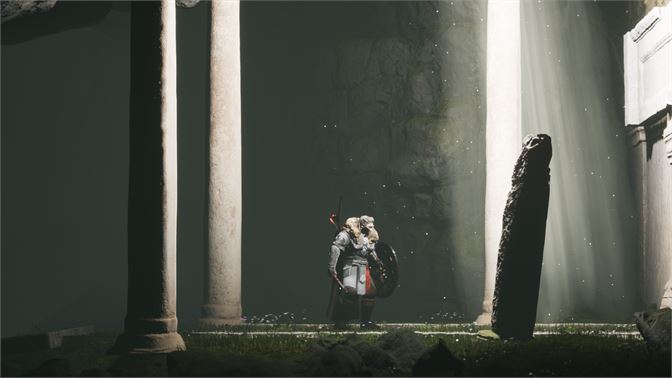
Song of Iron adopts a very minimalist style throughout. It has very little in the way of dialogue, presented as just a few lines of text. The majority of the storytelling is done visually, but this can be just as powerful as any voice acting. The game starts with your village being raided, and your character finding a “loved one” amongst the ruins of your burning village. They present you with a token that can be imbued with the power of the Gods, and your quest sees you travelling to the temple atop the mountain so you can gain the Gods’ favour and save what’s left of your people. There is an unexpected twist to this tale, which we won’t spoil here, but if you complete a second playthrough, you’ll notice subtle clues have been laid out that are easily dismissed by the untrained eye (or ear).
To progress through this world your character will have to engage in combat, some mild puzzle platforming and occasional stealth. The stealth sections are not fully explored, though, and aren’t essential for progression. There are a couple of places where you can sneak past some enemies or ambush them from the shadows, but you can just as easily go in gung-ho and fight them if you wish.
As mentioned, the minimalist style is utilised in all aspects of the gameplay. There are no mission objectives or waypoints, and for the most part, you’ll just be moving to the right to progress, but there are secrets to uncover, such as the upgraded armour you can find and the God gifted power-ups that allow you to imbue your blade with flame or lightning, or run at super-speed, so it’s worth exploring. There are a couple of points where it’s not immediately apparent what you need to do next, and where you’ll need to backtrack to find a newly opened route. Song of Iron is very old school in the way you explore, and it made me realise just how much hand-holding goes on in modern games. More games could do with just letting you get on with it because it’s far more satisfying figuring things out for yourself.
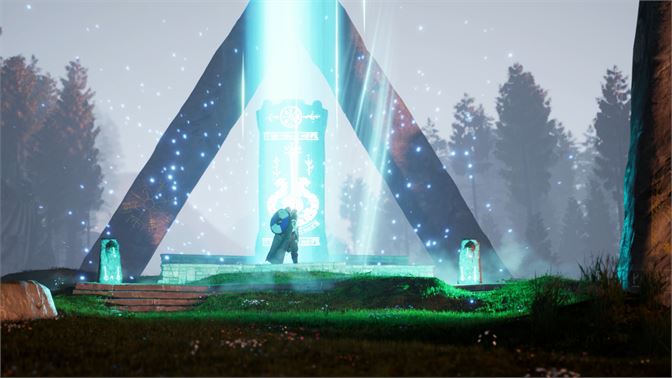
As much as this freedom can be liberating, it’s not without its issues. At one point near the start, reaching a checkpoint was supposed to open a trapdoor behind me, but it glitched out and I got stuck on top of it. After restarting the checkpoint, I jumped over the bit of scenery I got stuck on and spent a good fifteen minutes going back and forth trying to work out where to go next. It was only by checking a video online that I found out about the trapdoor and could progress. Despite this, it was still refreshing to be left to just get on with things myself.
The platforming was mostly enjoyable too. Some sections require you to carefully time jumps and dodges to avoid swinging objects and traps. A slight downside is that due to the camera angle, sometimes you can’t see them ahead of time to work out their pattern. When even slightly grazing them can result in instant and unrealistic death, it can be mildly frustrating. Thankfully, checkpoints are frequent and generous, so there is never too much unnecessary repetition, and it feels rewarding when you do complete them.
The combat, the thing you will be doing most in the game, is much slower than I expected, with your character swinging their weapon at a glacial pace. Such a large person wielding a small, single-headed axe shouldn’t be so slow in its execution. The sword and double-headed axe were slower again, and it felt like an age in combat, from the moment you wanted to strike to the actual strike. In addition to the “quick” strikes, there’s also a power move, but this takes so long to build up I almost never used it. It would have been better if there was a separate strong-attack button and some varied combos to make the combat more exciting.
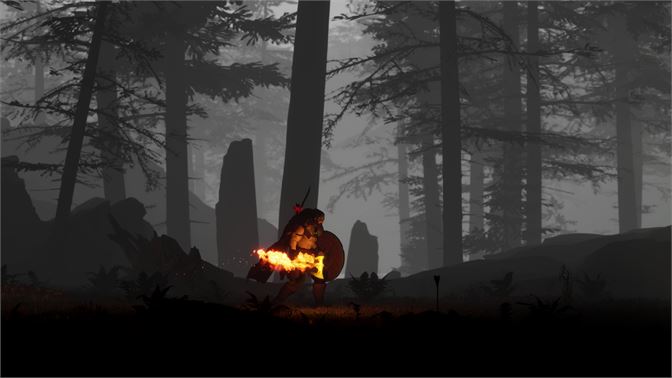
During your journey, you’ll come up against a variety of foes: From other Vikings to goblins and towering trolls. Although it’s in keeping with the mostly HUD-less presentation, there are no enemy health bars and no real visual clue if the swing of the weapon landed or whiffed, so you don’t get that visceral satisfaction from defeating anyone. As it is, you just end up slashing at enemies until they fall. Some kind of visual representation of the damage you’d dealt, or a more visible impact on the enemy would significantly improve this.
There isn’t a huge variety of weaponry; You can equip your character with axes, swords, spears, shields and a bow. Without any visible item attributes, there’s no way of knowing which is the best weapon in terms of damage or defence outside of simple trial and error. The best tactic usually revolves around making a couple of quick attacks, and then either blocking or rolling past enemies so you can attack them from behind, so the one-handed axes and sword were my go-to weapons of choice.
Power-ups become far more crucial to combat than weapon choice, though. Flame power deals damage over time, whilst lightning briefly stuns your opponent, and can quickly turn the tide of a battle. The activation of the lightning power (a double-press on the D-pad) was very unreliable, though, and too often ended up applying the flame effect instead.
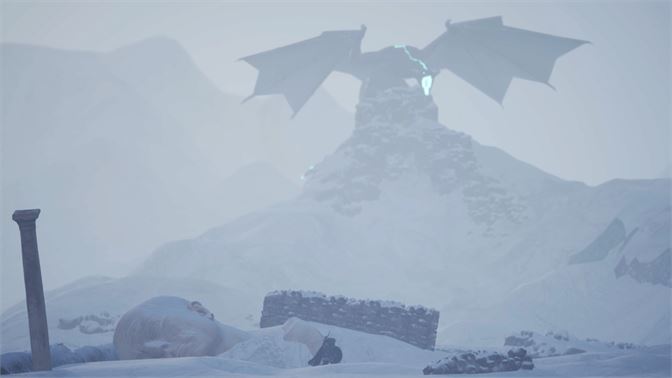
The bow and arrow quickly become your best friend when up against groups. The aiming system is challenging, as there is no directional marker or crosshair, so you’ll have to quickly judge it by eye. Once you understand how the aiming works, and as long as you don’t get flustered, it is simple to start picking off enemies from a distance to thin them out.
My favourite part of the combat, however, and the one that really made you feel like a true Viking, was the ability to throw your axe. It’s important that you don’t miss, though, as going up against enemies barehanded is never going to end well. Luckily, you can pick up dropped weapons from defeated enemies, so you will rarely end up unarmed. As you progress in the game you also gain the ability to recall the weapon from a distance (much like Kratos’ Leviathan axe recall in God of War), which encourages more axe throwing fun. The other interesting aspect of combat was that some of the shields can only withstand a few hits before splintering and breaking, so you can’t just hide behind them indefinitely.
Whilst at times the combat can be clunky and erratic, once you master the system of blocking, rolling and carefully timing your attacks, you’ll be picking off the toughest of enemies with ease, but Song of Iron certainly would have benefitted from more engaging combat. The addition of guard-breaking kicks, blocking and rolling gives you decent freedom of movement during combat, but it doesn’t quite make up for the simplistic striking.
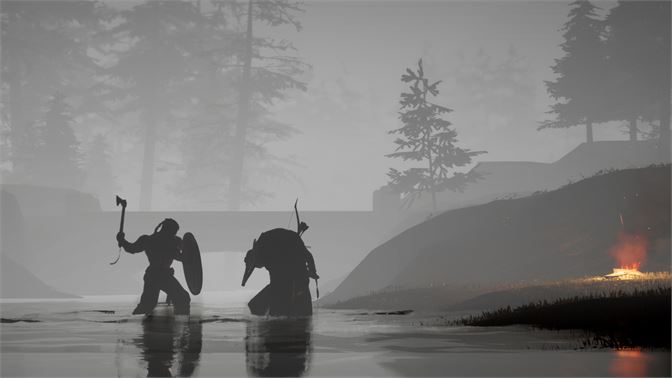
A final slight frustration with the combat is that, due to the nature of the design of the game, objects would pass by the camera in front of everything, such as a pillar or a tree, which can momentarily block out that part of the screen. Getting cornered by enemies behind one of these foreground objects literally meant you couldn’t see what you were doing, which is never a good thing during combat! Although the combat was enjoyable, with just a few additions to the move-set and better visualisation of the damage you were dealing it could have been so much better. As it is, it’s not quite up to the standard of the sumptuous visuals and impeccable musical score.
With the game taking a minimalist approach to in-game audio cues, most of the sound was provided by the rousing and inspiring soundtrack. Many of the background scores conveyed a wonderful sense of wonder and adventure befitting the stunning environments they were set in. Even though the combat may fail to impress, Song of Iron’s overall presentation is still excellent and is worth playing for the visuals and music alone. With a playthrough only taking a few hours, it’s a fairly short experience, but due to the unexpected twist in the closing stages, it’s something that will last in the memory long after the credits roll.
Summary
Considering this is the work of just one person, Song of Iron is a remarkably well made and entertaining game. Parts of the game, especially the combat, would have benefitted from more depth, and it can be glitchy and a bit rough around the edges, but it is a sterling effort from Joe Winter.
Stick with it, and you will be rewarded with an entertaining story, jaw-dropping vistas and a great experience from an extremely talented developer. The ending leaves Song of Iron open to a sequel, and I’d love to see what he can do with a bigger budget and a bit of help developing the systems further.

